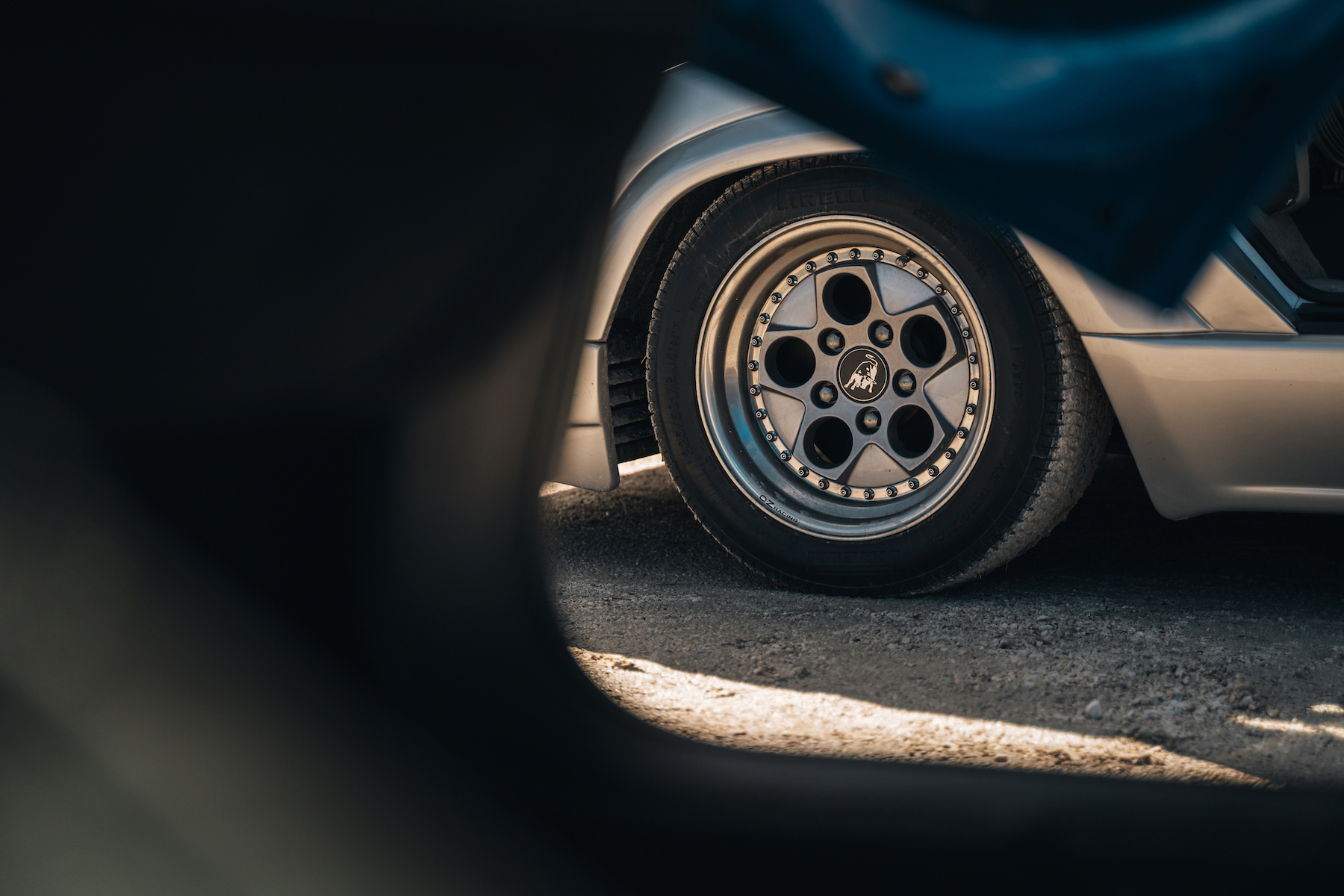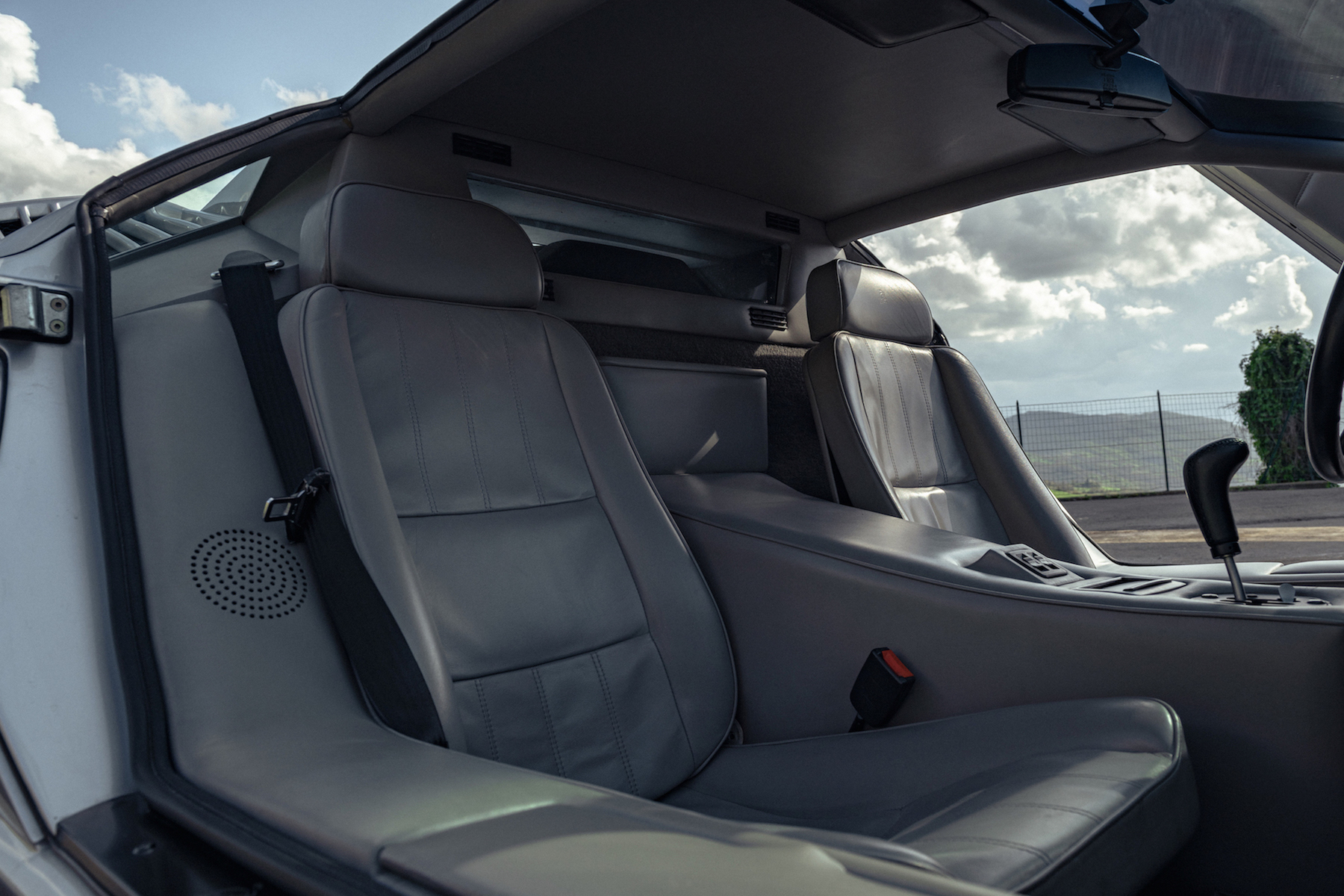Most automotive purists will say that the bombastic Lamborghini Countach only got uglier with age, and that the earliest, simplest version put forth by Bertone designer Marcello Gandini in 1971 remains the prettiest.
As someone who is aging myself, I cannot deny the notion that things rarely get prettier as they get older. Gandini’s youthful, sleek, wingless Countach concept is indeed the loveliest of the bunch.
But it isn’t my favorite.
Back in 1989, when I was a kid in the country lacking not in sweets but coming up short on culture, I had a big poster of the 25th Anniversary Edition Countach on my wall, purchased at my school’s Scholastic Book Fair. (That year I also purchased a copy of the groundbreaking literary classic, My Teacher is an Alien.)

I loved the Countach’s outrageous intakes, the dished wheels, and of course the massive delta wing clumsily slapped on the back. I’d only ever seen a Lamborghini once, a Countach parked in a suburban driveway that I’d barely spotted from the back of a school bus motoring home from a soccer match I’d likewise watched from afar. From the bench, that is. All those sweets didn’t exactly help my athletic prowess.
Sitting in the back of that bus, bored and nauseous, I was so dumbfounded by the sight of the car that I couldn’t even say anything. I didn’t tell any of my friends who were all focused on recounting the game that we’d probably lost. I just looked out the window and watched as the Countach scrolled by, an edgy spaceship that might as well have been from another dimension.

The five or so seconds I was within sight of that car was a foundational moment in my life. I remember it more vividly than any other single moment of my childhood. When I was lucky enough to drive a Lamborghini for myself almost 30 years later, a Huracan in 2016, I broke down in tears because the fat kid back then would never, ever have imagined getting a chance to drive one.
And dammit, now I’m crying again because I recently had yet another amazing honor. I was able to spend a morning in a Countach, a 25th Anniversary one at that, and though it lacked the big wing and was painted a subtle shade of silver instead of the garish red of the one on my poster, it was that same car I’d stared at from my room, the completion of a life goal so lofty I’d have never bothered to put it on a bucket list.

Prior to this opportunity, I confess I wasn’t even sure that I ever wanted to drive one. We’ve all heard the adage about never meeting your heroes. I, like I’m sure many of you, saw that Top Gear segment where James May drove a Countach and hated every second of it. I’ve also been fortunate to talk to Matt Farah enough to pick up bits and pieces about the complexities of owning one. All this has made it clear that the Countach is far from an ideal machine.
But the Countach is an interesting machine, to say the least. That initial design from Bertone looked like nothing anyone had ever put on wheels before, so shocking that its name is literally profane. According to Lamborghini lore, a local farmer peeked in the design studio, saw the car, and uttered “countach.” In the local Piedmontese dialect, the word literally means “plague” but is used when you’re in awe and don’t know what else to say—like you or I might utter “damn” if we spotted a box-fresh Chevy Lumina Z34 driving by. Designer Gandini thought it was funny. Others on the team thought it sounded great. The name stuck.

That amazing shape is a series of mostly aluminum panels mounted to a tubular steel space frame chassis, just like a race car of the time would have been. The Countach never saw a wind tunnel and its shape never subjected to the rigors of computational fluid dynamics; it just looked right, and back then that was really all that mattered.
Though the design was all-new, the engine was not, a 4.0-liter, 60-degree V12 taken virtually wholesale from the Countach’s predecessor, the Miura—which itself stole it from the Isolero, which borrowed the engine from the 400 GT, which ran an up-scaled version of the 3.5-liter V12 from the 350 GT, Lamborghini’s first car.

That V12, by the way, would survive in some form or another all the way up through the Murcielago, until emissions and Audi parentage finally necessitated something new for 2011’s Aventador. (Editor’s note: And people say “parts bin” like it’s a bad thing. -PG)

At launch, the 1974 Countach squared off such supercar greats as the (don’t call it a Ferrari) Dino 246 GT, Porsche’s 911 Carrera RS 3.0, and the De Tomaso Pantera. With an MSRP just over $50,000, it cost about as much as the other three put together. But over the next 26 years of production, the Countach would also face off against the Ferrari 308 GTB, 328 GTB, and even the 348 before finally being put out to pasture in 1990.

That initial 1974 Countach was officially called the LP400. The LP means “longitudinale posterioire,” a reference to rotating that motor by 90 degrees from its transverse arrangement in the Miura. That engine still sits behind the driver, but not quite in the center line of the car. It’s offset slightly to the left to offset the driveshaft, which runs from the front-mounted transmission back through the oil pan to drive the wheels at the rear.
The 400 in the name refers to the displacement, which through the course of the Countach’s remarkable 16 years of production would eventually grow by more than a liter. The name of the car would change along the way, too, culminating with the 25th Anniversary Edition you see here.

In the mid-1980s, a relatively young, unknown designer named Horacio Pagani was given the task of modernizing the Countach and giving it a few more years of life before its ultimate replacement. He worked on a project to create a fully carbon-bodied car with a new chassis, a concept called the Countach Evoluzione. The prototype weighed a remarkable 1,100 pounds less than the Countach, which had swelled to 3,500 pounds by the time the 25th Anniversary Edition came around. That’s an impressive delta, despite the Evoluzione lacking an interior. The Lamborghini brass, however, weren’t impressed by the costs of producing lightweight composites wholesale, so Pagani’s other project, the 25th Anniversary Edition Countach, used composites sparingly, for just a few of the many new body panels.

But no ergonomic oddity nor logistical quirk was ever going to quench the love in my heart for that car. And so, when Lamborghini offered up an opportunity to drive one, plus a smorgasbord of other period bulls to celebrate the company’s 60th anniversary, I didn’t have to think twice. All I had to do was count the days.
This, though, isn’t just any 25th Anniversary Edition. This is the very last one ever built, assembled on July 4th, 1990, then shuttled next door into the Lamborghini Museum in Sant’Agata, Bologna, where it was destined for a quiet life of leisure. Mostly quiet, anyway. It gets dragged out of retirement to make some noise for certain special occasions, like Lamborghini’s 60th anniversary, to be driven by lucky so-and-sos like myself.

My first taste of the Countach experience was a painful one. Literally. I opened those iconic scissor doors and, perhaps a little too quickly, certainly a little too easily, swung my legs inside. I lifted my feet a bit to clear the massive sills and managed to slam my right knee into the sharp edge at the bottom of that door.
You know when you catch the fleshy bit under your kneecap just right and it hurts so much you feel the urge to vomit? Yeah, it was one of those moments, exacerbated by my having bruised that same knee the weekend before when took a tumble while carrying a chainsaw, having tripped over a branch on a tree I’d just felled. (Yes, I do live a charmed life.)

Thankful that the damage wasn’t done to my clutch leg, and determined to tolerate even permanent knee damage if it meant completing this drive, I made to start the car. I stepped on the clutch and thought, “This isn’t as stiff as everyone said.”
And then I looked down at my feet and realized I was stepping on the brake pedal.
Knowing how legendarily slim the Countach’s pedal box is, I’d worn my most slender of non-racing shoes. (Non-racing because nobody wants to be that guy at a media drive event clomping around all day in race booties, or worse, those Piloti loafers.) Even those kicks weren’t slender enough. The gap between throttle and clutch, brake pedal situated in the middle, of course, was barely bigger than my shoe was wide.

Pedal identification on this particular Countach was made ever more problematic by the brake pedal being the softest of the three. Even the throttle was reluctant, but I didn’t find the clutch to be as quad-burning as I’ve heard many others complain. For that, I’m tempted to thank my love of cycling. All those hill-climb repeats over the years were paying off.
After finding the clutch, I brought the gated shifter from neutral and fired up the ignition and the smiles.

I pulled the door down, which slammed shut with a loud clunk, then was immediately admonished by one of the Lamborghini engineers for not slamming it hard enough. It hadn’t fully latched. So, I sent it skyward again, swung it down a second time, got a thumbs up, and slotted the car into first.
First is down and left, a dogleg arrangement that positions reverse in the upper-left, blocked off by a beefy, machined mechanical lockout you need to move out of the way with your thumb. This I was thankful for, since I’d just climbed out of the Miura, which has the more standard gear arrangement with first in the upper-left.
Referring to a shifter as moving like a rifle bolt is perhaps the ultimate of automotive journalism cliches, but I couldn’t help wondering if this is where it started, because the process of moving from first into neutral, then neutral into second really felt like chambering a round in a bolt-action 30-06. That you can peek down through the black anodized shifter gate and see the mechanism working within just makes it all the more precious.

Reader, I didn’t stall the Countach. I pulled away without fuss, V12 having enough moving parts with enough inertia that I barely needed to touch the throttle as I released the clutch. And, since the Countach will gladly run past 60 mph in first gear, I was able to linger there for a little while as I figured out everything else.
I’d pushed the seat back as far as it would go in a vain attempt at getting comfortable. This left me with my arms at almost full extension. Not ideal in any car, especially one that requires as much strength to turn as this.

When it was time for the one-two shift it happened slowly, synchros reluctant and me not comfortable enough with those pedals yet to risk a double-clutch. A single actuation was trying enough at first. But, as the kilometers piled on and the roads opened, I started to find my footing. A quick lift of the clutch on the up-shift while swinging through neutral made the next gear slot in delightfully, while a little blip of the throttle during the lift on downshifts made everything move much more quickly in that direction, too.
The problem was that brake pedal, so soft and sunk so low that I couldn’t really get the angles right. No racing downshifts for me that day.

I would, though, wring that delightful V12 out at every opportunity. Driven moderately, the Countach is loud but not terminally so, sounding positively refined in comparison to the Miura, which is unhinged at any rev. But the Countach rewards throttle and revs, its characteristic snarling exhaust note growing more intense with every dose of extra spin you request. Redline is marked at 7,500 RPM and the acoustic reward only gets sweeter the higher you go. Matching that, as the Countach gains speed it starts to move and bounce on the uneven Italian rural lanes, singing and dancing better than any Broadway show I’ve ever seen.

The steering gets lighter with speed and all the ergonomic foibles stop meaning so much. Likewise, the truly awful interior, with plastic vents so brittle I didn’t dare adjust them, seemed to fade from my line of sight as I gazed through that big, swept windshield and hoped the road ahead was empty so that I wouldn’t have to test those terrible brakes.
Screaming through the Italian countryside with the sun shining overhead was a total and utter rush.
And of course, an overwhelming dose of nostalgia that set the aforementioned wetworks flowing. But the problem with nostalgia is that it’s a reconnection with something old, something you don’t see anymore, and that’s often for a good reason.

The Countach is, of course, largely a product of the 1960s, of a different time with different expectations and needs. It really can’t even be compared to how modern cars get designed today. Its priorities were wholly different. Those straight pipes sticking out the back sound lovely but they aren’t doing the environment any favors. The lack of traction control or even ABS isn’t exactly compatible with today’s standard of driving, and while I don’t know what would happen in a crash I do know it wouldn’t be good.

We can lament Lamborghini’s new Revuelto being bigger and softer and heavier than this, the addition of a plug-in hybrid system and airbags and drive modes muddying the experience. But we should also appreciate that the new car, with its 1,001 horsepower and all-wheel-drive, weighs just 400 pounds more than the 25th Anniversary Countach. That’s remarkable.
But there is of course something endlessly charming about that old Countach, something that still makes me smile thinking about it. After my time behind the wheel, I got an unexpected sign that it isn’t just nostalgia at play.
This car was part of a parade of sorts, eight historic Lamborghinis sprung from the museum for a few lucky journalists like myself to experience as part of the 60th-anniversary celebrations. We’d all pulled up in the small town of Ariosto, probably five or six million dollars worth of exotica street-parked.

I was limping around on the sidewalk, nursing my busted knee, grabbing a few photos of the car for the ‘Gram and wondering whether I’d need a wheelchair assist to get through the sprawling terminals at Schiphol Airport the next day.
A young, local couple with two kids came by, eyes wide. The father asked permission, which I of course granted, and soon both son and daughter were posing excitedly by the Countach.
They wandered down to check out the Diablo and then the Miura and all the other wonders, but a few minutes later the boy, who was about the same age I was when I was in the back of that school bus in Vermont all those years ago, came back to look at the Countach again.
“How model?” he said in broken English.
“Scusi?” I asked, testing the limits of my Italian.
“Model?” he asked, pointing at that silver wedge from another dimension.
“Ahh, Countach.” I said, then repeated it for him.
He turned back to the car, nodded once, and said “Bella.”

Tim Stevens is an automotive journalist based in New York. The former Editor-in-Chief of CNET’s Roadshow, his work has appeared in TechCrunch, MotorTrend, The Verge, Jalopnik and many more places.
All photos via Lamborghini





A few years ago, I was working on my car in the driveway. Little suburban neighborhood in San Diego, very quiet. As I’m waking out of the garage towards my car, I heard an alien sound coming from up the street. It was definitely a car, but the engine noise didn’t register with me what it could be. My jaw dropped and I just stood there as I watched a cocaine white Lamborghini Countach drive by. Just stunned! I couldn’t move. Couldn’t say a word….. just admired it.
Luckily our security camera was able to capture it and I could share my encounter with greatness with the world.
https://www.curbsideclassic.com/blog/in-motion-classic/in-motion-classic-1985-lamborghini-countach-5000s-sophia-loren-strolls-by/
I read decades ago in a French magazine that the legend went about the Diablo being actually (relatively) easy to get in or out of because Lee Iacocca had pinched a vertebrae getting out of a Countach when Chrysler bought Lamborghini in 1987.
Wonderfully written article. Such an iconic car….not great, but it means so much to SO many people, just the sight of it. Dream come true for you friend! 🙂
Not just the greatest car ever made, but quite simply the greatest thing ever made. Aliens could land in intergalactic spacecraft and we’d still have the Countach to one-up them
Schoolastic Book Fair was such an instant dopamine hit of nostalgia I had to immediatley comment.
Man, those were great. I loved the book fair and catalogs we got to take home and convince our parents to indulge. Never hard to convince the parents to get the next Goosebumps book, or whatever. Anyways, back to the article.